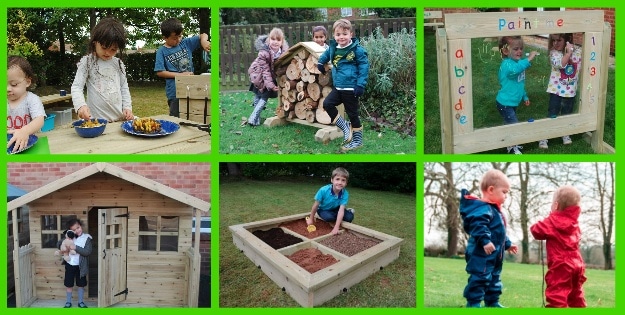
Research shows that children are spending less time outside, discovering the natural world. It’s a shame, but the popularity of computer games, all day kids’ television and a fear of child abduction have shrunk the amount of time that children play outside . . .
This trend is a problem. Not only are children at risk of being disconnected with their natural surroundings, but this shift is affecting their development too. Check out this quote:
“Research shows that children use five times as many words when they play outdoors compared to indoors, and that there’s a direct correlation between obesity and lack of time spent outside.” (Source: CBeebies grown-ups).
As a result, it’s really important that early years settings embrace opportunities for outdoor play and help children get connected with nature.
Here are some ideas for taking learning outside:
1. Promote physical development
Children feel much less constrained and constricted when outdoors. There’s more freedom to run and explore and more space to let loose. In turn, this promotes physical development and also physical fitness. Space to run, jump and climb, promotes a whole range of muscular development and fitter, more active children are more likely to avoid childhood obesity.
2. Encourage children to assess risk
Unstructured play in the great outdoor allows children to discover more about their world. For example, children can discover what poses danger and what doesn’t. In this way, children can learn to take calculated risks – and this boosts their confidence. For example, it’s all very well learning about plants, insects, animals and wildlife on the TV and in books but it is no substitute for first-hand experience.
3. Language development
When children are outside, they’re exposed to a multi-sensory experience. There’s so much to hear, feel and taste! (OK, you need to watch out for the tasting!) When children have the opportunity to discover new things, there is a language benefit to this too. Talking about their discoveries and their experiences and putting words to the new things that they’ve uncovered is an invaluable learning opportunity.
4. Structured outdoor play
Whilst children can gain a huge amount from unstructured outdoor play, settings can create a rich learning experience through the activities they create. For example:
- A bug hunt can be a great introduction to the world of mini beasts
- Collecting natural treasures is an activity that can easily be continued at home (and nurture those all-important home-setting links)
- There’s enormous scope for nature-inspired loose parts play, where children can collect their own selection of goodies and mix and match with items you have in the setting
- Mud kitchens are a fun way to encourage children to roll up their sleeves and get ‘cooking’ with items they find outside. Dinner can then be served up in an outdoor house!
- Create habitats for wildlife such as butterflies, ladybirds and hedgehogs and allow children to study nature up close – this minibeast habitats set makes it easy
- Construction challenges can offer a multidimensional learning experience – from makeshift obstacle courses, to channelling and digging with stones, sand, soils and pebbles
Enthusiastic, adventurous children don’t mind getting wet so whilst the good weather in the summer months easier for settings to take learning outside there’s not real reason to let rain stop play. Instead, throw on a waterproof suit and some welly boots and get back in touch with nature.
How do you ensure the children in your setting make the most of the outdoors? Please share your outdoor classroom ideas in the comments below.
